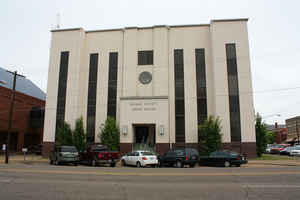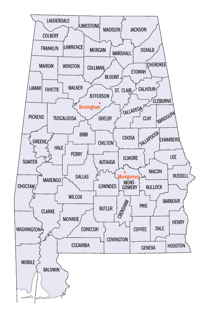Dallas County, Alabama History
Dallas County Education, Geography, and History
Dallas County is a county of the state of Alabama. Based on the 2010 census, its
population was 43,820. Dallas County was
created on Feburary 9, 1818, from portions of the Creek cession
of August 9, 1814, Monroe County and Montgomery County. The county
seat is Selma. The county is named in honor of United States Secretary of the Treasury Alexander J. Dallas, who served 1814-1816.
Dallas County comprises the Selma, AL Metropolitan Statistical Area.
Etymology - Origin of Dallas County Name
It was named for Alexander J. Dallas of Pennsylvania, US Treasury Secretary.
Demographics:
County QuickFacts: CensusBureau Quick Facts
County History
Dallas County, Alabama
Formed by the Alabama Territorial legislature on 1818 Feb. 9, from portions of the Creek cession of 1814 Aug. 9. It was named for Alexander J. Dallas of Pennsylvania, US Treasury Secretary. Dallas County is located in the Black Belt region of the west-central portion of the state, and is traversed by the Alabama River. Dallas is bordered by Perry, Chilton, Autauga, Lowndes, Wilcox, and Marengo counties. It currently encompasses 975 square miles. Originally, the county seat was at Cahaba, which also served as the state capital for a brief period. In 1865, the county seat was transferred to Selma. Other towns and communities include Marion Junction, Sardis, and Orrville.
The county is traversed by the Alabama River, flowing from northeast to southwest across the county. It is bordered by Perry, Chilton,
Autauga, Lowndes, Wilcox, and Marengo counties. Originally, the Dallas county seat was at Cahaba, which also served as the state capital for a
brief period. In 1865, the county seat was transferred to Selma. Other towns and communities in the still mostly rural county include Marion
Junction, Sardis, Orrville, Valley Grande, and Minter.
Cotton production suffered in the early 20th century due to infestation of boll weevil. The still mostly rural county reached a peak of
population in 1960. Younger people have since left to seek work elsewhere. The county is working on new directions for economic development.
At the turn of the 20th century, the state legislature disenfranchised most blacks and many poor whites through provisions of a new state
constitution requiring payment of poll tax and passing a literacy test for voter registration. These largely survived legal challenges, but in
the postwar era of the 1950s and 1960s, African Americans mounted new efforts across the South to be able to exercise their constitutional
right as citizens to register and vote.
From 1963 through 1965, Selma and Dallas County were the sites of a renewed Voting Rights Campaign. It was organized by locals of the Dallas
County Voting League, and joined by SNCC activists. In late 1964 they invited help by SCLC leaders. With Martin Luther King, Jr.
participating, this campaign attracted national and international news in February and March 1965. Two activists were killed before the final
march took place.
On March 7, several hundred peaceful marchers were beaten by state troopers and county posse after they passed over the Edmund Pettus Bridge
and into the county, intending to march to the state capital of Montgomery. The events were covered by national media. The protesters renewed
their walk on March 21, having been joined by thousands of sympathizers from across the country and gained federal protection, to complete the
Selma to Montgomery March. Some 25,000 people entered Montgomery on the last day of the march. In August of that year, Congress passed the
Voting Rights Act of 1965, which was signed by President Lyndon B. Johnson. Millions of African-American citizens across the South registered
and voted in the subsequent years, participating again in the political system.
Geography: Land and Water
As reported by the Census Bureau, the county has a total area of 994 square miles (2,570 km2), of which 979 square miles (2,540 km2) is land and 15 square miles (39 km2) (1.5%) is water
Neighboring Counties
Bordering counties are as follows:
- Northeast: Chilton County; Autauga County
- Southeast: Lowndes County
- Southwest: Wilcox County
- West: Marengo County
- Northwest: Perry County
Education
Areas not in Selma are served by Dallas County Schools, while areas in Selma are served by Selma City Schools.







